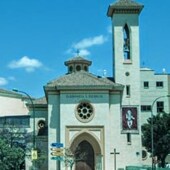Malaga honours its own 'Saint Patrick'
While the Irish are honouring St Patrick on 17 March, in Malaga they are remembering their own San Patricio - the first bishop of the city - the day before
Alekk M. Saanders
Malaga
Martes, 14 de marzo 2023
Many legends have developed around the life of San Patricio of Malaga because much of it is obscure, and cannot be clearly verified. His date of birth is uncertain but obviously he was born toward the end of the third century. That is a bit earlier than Saint Patrick of Ireland, who was born in the second half of the fourth century.
The Bishop of Malaga
San Patricio is considered the first bishop of the Diocese of Malaga, the first known ecclesiastical council of the Christian church in Spain, at least it is recorded so in the canons of the Synod of Elvira (now Granada) held in the first decade of the 4th century. Bishop Patricio represented Malaga, together with his advisers - 'sacerdotes' (priests) from Teba, Ronda and Alhaurín el Grande. Any further history of San Patricio in Malaga is inevitably sketchy. But it is known that finally San Patricio had to leave Malaga.
Many legends have developed around the life of San Patricio of Malaga because much of it is obscure, and cannot be clearly verified
The bishop exercised his apostolate during the government of the Roman emperor Diocletian. At that time the Christians suffered religious persecution with numerous martyrs. According to popular legend, some of the patrons of Malaga were martyred on the banks of the Guadalmedina. Patricio himself was also the object of the cruel persecution of Christians, therefore he went into hiding and eventually managed to escape, apparently, to Gaul, where he died on 16 March, 307. This explains why San Patricio of Malaga is registered in the Roman Martyrology as Bishop of Auvergne of Gaul. However, his name cannot be found in the lists of bishops of that region.
There is also a story, that he is a replica of Saint Patrick of Ireland, actually created by mistake. It is believed that this was just an ignorant copyist who once read 'Arvernia' (Auvergne) instead of 'Hibernia' - the Classical name for the island of Ireland. Incidentally, Arvernia was named after the Arverni - a Celtic tribe – that lived in the middle of today's France in the second century BC.
Since old times, the church in Malaga has religiously kept Patricio's memory alive and venerated him with piety
Since old times, the church of Malaga has religiously kept Patricio's memory alive and venerated him with piety. On 26 April 1834, Pope Gregory XVI decreed San Patricio's public worship and designated 16 March to celebrate his memory annually. His feast day in the diocese of Malaga is celebrated on 18 August. In San Patricio's honour, Malaga named a street after him in the very centre of the city.
The Church in Huelin
Malaga has a church named after San Patricio, La Iglesia de San Patricio, which is in the Huelin neighbourhood. The work on the church started in 1875, thanks to the owner of a sugar factory, Eduardo Huelin Reissig, born in Malaga in 1822 to British/Irish immigrants.

The work on the church started in 1875, thanks to the owner of a sugar factory, Eduardo Huelin Reissig, born in Malaga in 1822 to British/Irish immigrants
Eduardo Huelin Reissig built a small chapel for his workers. In the beginning this primitive chapel was dedicated to the Virgin of Sorrows (Virgen de los Dolores), but during its first fifty years, it served as a seat of the Parish of San Patricio. During the riots of 10-13 May, 1931, when over one hundred convents and other religious buildings in Spain were burnt, the San Patricio chapel was also seriously damaged by the anarchists and Republican extremists. On the night of 12 May, its entire parish archive consisting of 15 baptismal books, as well as its sacred images and worship equipment were burnt to the ground. The years that followed, both during and after the Civil War, were particularly painful for both the neighbourhood and the parish.
The life of the parish began to normalise in the 1940s. In 1955 the new Parish Centre of San Patricio was inaugurated. Today's building was designed by the famous Malaga architect Fernando Guerrero-Strachan Rosado. After his sudden death in 1950 the project was finished by Enrique Atencia. The church is unique for Malaga due to its Gothic aesthetic and Mudejar style.
Incidentally, the mass, celebrating St Patrick of Ireland, has been held in the Malaga church since 2005.
